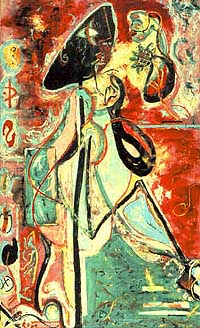The Moon Woman Cuts the Circle - Jackson Pollack

 So, De Kooning pops his head in.
So, De Kooning pops his head in.
"Hey, Dead Beat you up yet?"
"Never sleep, Willy."
"You been giving my friend Jackson a hard time?"
"To the contrary."
"He was contrary, was he not? Anyway listen D.B. "He broke the ice."
"Yes, I know."
"No you don't Dead Beat. He broke the ice."
"Willy Boy, it has been suggested that Pollock was influenced by Native American sand paintings, made by trickling thin lines of colored sand onto a horizontal surface and that not until 1947 didPollock began his "action" paintings, influenced by Surrealist ideas of "psychic automatism" (direct expression of the unconscious). Pollock would fix his canvas to the floor and drip paint from a can using a variety of objects to manipulate the paint."
"So what of the painting above , D. B.?"
"The Moon-Woman Cuts the Circle (1943; 109.5 x 104 cm (43 x 41 in)) is an early Pollock, but it shows the passionate intensity with which he pursued his personal vision. This painting is based on a North American Indian myth. It connects the moon with the feminine and shows the creative, slashing power of the female psyche. It is not easy to say what we are actually looking at: a face rises before us, vibrant with power, though perhaps the image does not benefit from labored explanations. If we can respond to this art at a fairly primitive level, then we can also respond to a great abstract work such as Lavender Mist. If we cannot, at least we can appreciate the fusion of colors and the Expressionist feeling of urgency that is communicated. Moon-Woman may be a feathered harridan or a great abstract pattern; the point is that it works on both levels."
"I thought I was a wreck but D.B. you take the biscuit."
"At least I can paint Willy boy, at least that."
"D.B. you couldn't paint yourself out of a paper b..."










No comments:
Post a Comment